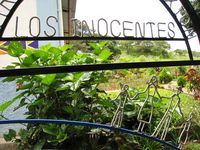Arriving in El Salvador certainly brought with it a change in feeling compared to the other areas of Central America such as Panama and Costa Rica.
In all the time spent in El Salvador we only saw 8 other travellers and minimal tourist development. In some ways El Salvador reminded me a little of Colombia - With its recent civil war history and the rest of the world looking at it as a 'trouble spot' - yet the people there are amongst the friendliest and most helpful we've met. Like Colombia, I feel that the people there make a very special effort with the travellers they meet because they know the world looks at them and their country as drug producers, guerrillas or just bad people. Simply not fair and certainly not true.
El Salvador had a pretty tough history even through the more recent years. I only really remember it as a place that was being mentioned on the news a lot when I was at school. The civil war there started in 1980 and ran on until 1992 - although the history runs way back beyond that.
It was a war between the right-wing military government of El Salvador (U.S. funded to the tune of 7 Billion Dollars) and the Farabundo Martí National Liberation Front (FMLN), a coalition of four leftist and one Communist guerrilla group. Basically a long and very bloody war of the oppressed people against a brutal military dictatorship.
One of the first places we visited in El Salvador was the small village of El Mozote which became infamous as the site of a brutal massacre by Government troops at the end of 1981. The north eastern areas of El Salvador were considered to be something of an FMLN stronghold and it was in these areas that the government implemented 'death squads' whose role was quite simply to wipe out whole communities.
Although this happened in many areas of El Salvador, it was the scale of the massacre in El Mozote that makes it stand out.
Almost 1000 men, women and children were tortured and killed in this small rural village. Only one person managed to escape and survive. Everthing in the town was destroyed including all livestock. Nothing was left alive.
 The Memorial Rose Garden
The Memorial Rose Garden
There are believed to be numerous, as yet unidentified, mass graves around the village. However, the one that has been exhumed is perhaps the most tragic of all. In 2003 an Argentinian forensic team uncovered a mass grave in which they found 146 bodies. Of the 146 corpses, 140 of them were aged under 12 years old, and the average age was 6 years old! The youngest was just 2 days old!
This site has now become a dedicated momument to all those who were killed in the village. The childrens mass grave transformed into a memorial rose garden.
When we were there, we were lucky enough to meet two very interesting people. One was an English girl who was working for the church. She had helped create the original mural and rose garden in dedication to the children 4 years earlier. She had just returned to carry out a little repair work on the paint job.
The other was an American author who had published a book about the Mozote Massacre. He had been in Mozote back in 2003 when the forenic work was being carried out on the childrens grave. He had just come back to El Mozote after 5 years with thoughts of updating his book. Both these people were able to give us an amazing insight into the tragic events of the village and what happened afterwards.
On March 7, 2005, the Inter-American Commission on Human Rights reopened an investigation into the El Mozote massacre because of the new evidence found by the team of Argentine forensic anthropologists. Unfortunately however, recent efforts by lawyers in El Salvador to reopen the case, which was shelved in 2000, have repeatedly failed, even after a court ruling that year stripped protection under the national amnesty law from suspects in the most egregious human rights violations.
War... what is it good for!